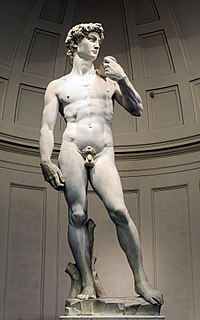
Girolamo Francesco Maria Mazzola was an Italian Mannerist painter and printmaker active in Florence, Rome, Bologna, and his native city of Parma. His work is characterized by a "refined sensuality" and often elongation of forms and includes Vision of Saint Jerome (1527) and the iconic if somewhat untypical Madonna with the Long Neck (1534), and he remains the best known artist of the first generation whose whole careers fall into the Mannerist period.
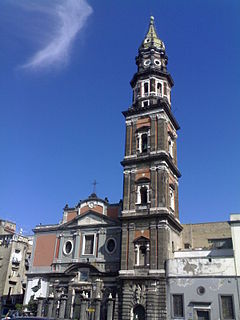
Santa Maria del Carmine is a church in Naples, Italy. It is at one end of Piazza Mercato, the centre of civic life in Naples for many centuries until it was cut off from the rest of the city by urban renewal in 1900. The church was founded in the 13th century by Carmelite friars driven from the Holy Land in the Crusades, presumably arriving in the Bay of Naples aboard Amalfitan ships. Some sources, however, place the original refugees from Mount Carmel as early as the eighth century. The church is still in use and the 75–metre bell tower is visible from a distance even amidst taller modern buildings.

San Giovanni a Carbonara is a Gothic church in Naples, Southern Italy. It is located at the northern end of via Carbonara, just outside what used to be the eastern wall of the old city. The name carbonara was given to this site allocated for the collection and burning of refuse outside the city walls in the Middle Ages.

Sant'Anna dei Lombardi,, and also known as Santa Maria di Monte Oliveto, is an ancient church and convent located in piazza Monteoliveto in central Naples, Italy. Across Monteoliveto street from the Fountain in the square is the Renaissance palace of Orsini di Gravina.

Rocco Marconi was an Italian painter of the Renaissance period, active mainly in Venice and Treviso. He was a pupil of the painter Giovanni Bellini along with Vittore Belliniano and Girolamo Santacroce. His first wife died in 1511. He is known to have joined the Venetian painters' guild (fraglia) in 1517, and the Scuola di Sant’Anna in 1526.
Girolamo Abos, last name also given Avos or d'Avossa and baptized Geronimo Abos, was a Maltese-Italian composer of both operas and church music.

Francesco Rizzo da Santacroce, also known as simply Francesco da Santacroce or Francesco di Bernardo de' Vecchi Da Santa Croce was an Italian painter of the Renaissance period, active mainly in Bergamo and Venice.
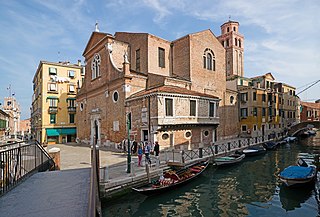
San Martino is a Renaissance Roman Catholic church in the sestiere of Castello of Venice, northern Italy.

Girolamo da Santacroce was a 16th-century Italian painter of the Renaissance period, active mainly in Venice and the Venetian mainland.

The Italian Catholic Archdiocese of Chieti-Vasto received that name in 1986. The historic Archdiocese of Chieti was elevated from a diocese in 1526.

Fabiano Santacroce is an Italian professional footballer who plays for Italian club Cuneo in Serie C and is the club's captain. He plays as a defender in the centre or on the left. He was born in Brazil to an Italian father and an Afro-Brazilian mother, then spending his childhood in the Lombard town of Casatenovo, in Northern Italy. At international level, he has represented the Italy national under-21 football team.
Francesco Peparelli was an Italian architect during the 17th century. He designed the Palazzo Valentini and contributed to the design of Santa Maria in Traspontina. Peparelli taught and later collaborated with Giovan Antonio de' Rossi.
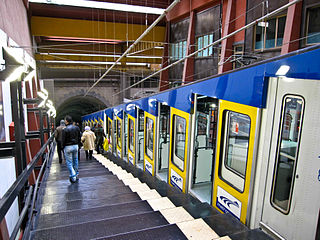
The Montesanto Funicular, is a funicular railway line that forms part of the public transport system for the city of Naples, Italy. Opened in 1891, the Montesanto Funicular carries over 4 million passengers per year.

The Galleria nazionale di Parma is an art gallery in Parma, northern Italy.
Santa Croce is Italian for "Holy Cross" and may refer to:

Santa Maria delle Grazie Maggiore a Caponapoli or Santa Maria delle Grazie Maggiore is a church located in the historic center of Naples, Italy.
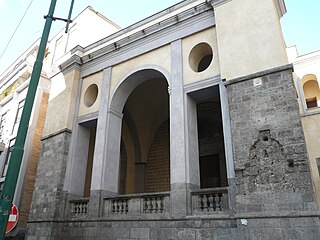
Sant'Agnello Maggiore, also called Sant'Aniello a Caponapoli or Santa Maria Intercede, is a church in the historical center of Naples, Italy.

Santa Maria del Parto a Mergellina is a church located in the quartiere of Chiaia in Naples, Italy. The church is peculiarly perched on top of a private building, and accessed by a strairway, placed behind a restaurant located in piazza Mergellina.
Alessandro Oliverio (1500–1544), was an Italian painter.

Francesco di Simone da Santacroce or Santa Croce was an Italian painter, active mainly in a Renaissance style. He was influenced by Giovanni Bellini.



